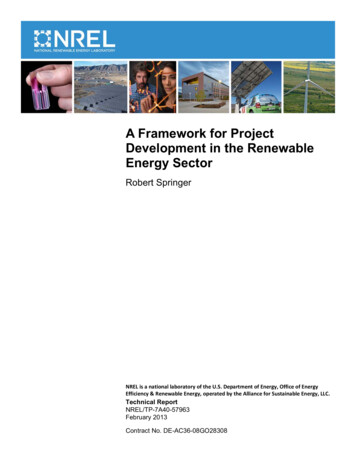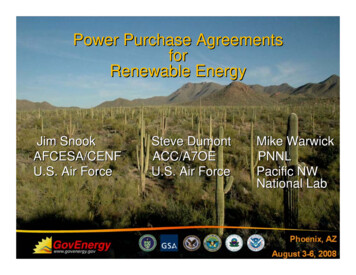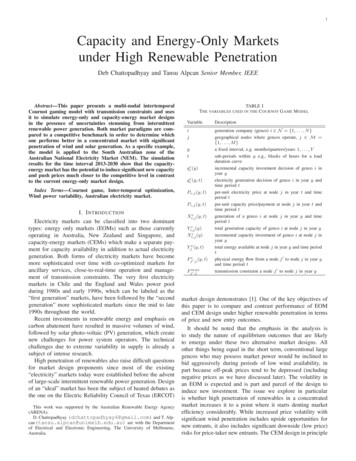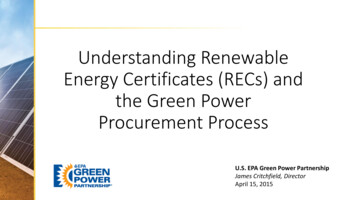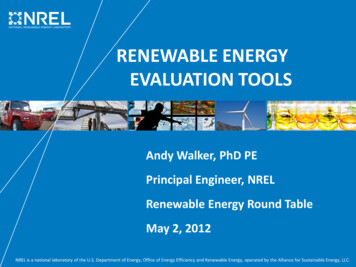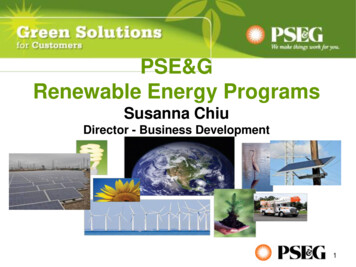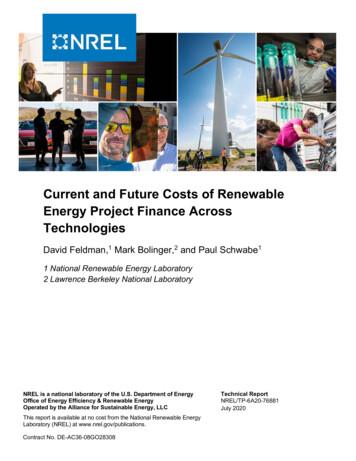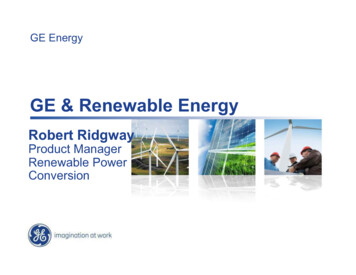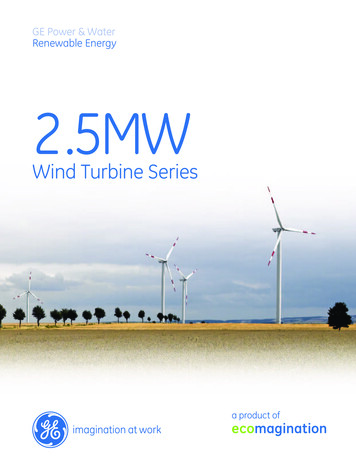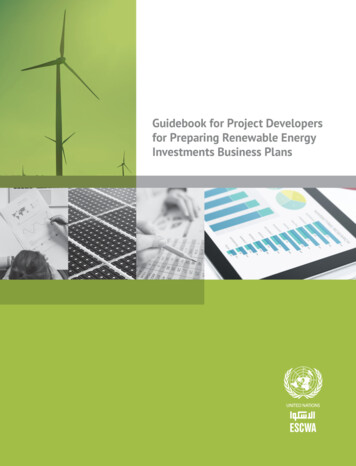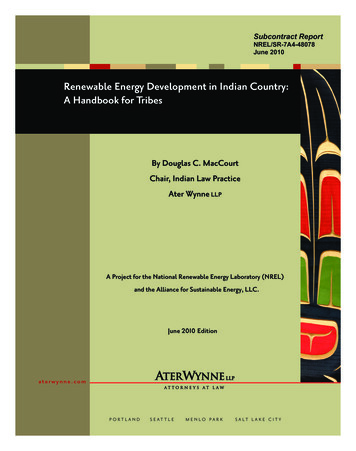
Transcription
AterWynne IndianLawCover.qxd6/24/1012:33 PMPage 1Subcontract ReportNREL/SR-7A4-48078June 2010Renewable Energy Development in Indian Country:A Handbook for TribesBy Douglas C. MacCourtChair, Indian Law PracticeAter Wynne LLPA Project for the National Renewable Energy Laboratory (NREL)and the Alliance for Sustainable Energy, LLC.June 2010 Editionaterwynne.comPORTLANDSEATTLEMENLO PARKS A LT L A K E C I T Y
RENEWABLE ENERGY DEVELOPMENT IN INDIAN COUNTRY:A HANDBOOK FOR TRIBESA Project for the National Renewable Energy Laboratoryand the Alliance for Sustainable Energy, LLCunder Subcontract No. AEK-9-88294-01Technical monitor: Roger TaylorBY DOUGLAS C. MACCOURTCHAIR, INDIAN LAW PRACTICE GROUPATER WYNNE LLPE DI T OR SD OUG L A S C . M A C C OUR TJ OH N M . S C H UL T ZC ONT R I B UT I NG A UT H OR SL . D A V I D C ONNE L LD OUG L A S C . M A C C OUR TR OB R OY S M I T HA L I C E C UPR I L L C OM A SW I L L I A M H . P R E NT I C EBy Douglas C. MacCourt. All Rights Reserved.Copyright 2010 by Douglas C. MacCourt and Ater Wynne LLPNational Renewable Energy Laboratory1617 Cole Boulevard, Golden, Colorado 80401303-275-3000 www.nrel.govNREL is a national laboratory of the U.S. Department of EnergyOffice of Energy Efficiency and Renewable EnergyOperated by the Alliance for Sustainable Energy, LLCContract No. DE-AC36-08GO28308i
NOTICEThis report was prepared as an account of work sponsored by an agency of the United Statesgovernment. Neither the United States government nor any agency thereof, nor any of theiremployees, makes any warranty, express or implied, or assumes any legal liability orresponsibility for the accuracy, completeness, or usefulness of any information, apparatus,product, or process disclosed, or represents that its use would not infringe privately ownedrights. Reference herein to any specific commercial product, process, or service by trade name,trademark, manufacturer, or otherwise does not necessarily constitute or imply its endorsement,recommendation, or favoring by the United States government or any agency thereof. Theviews and opinions of authors expressed herein do not necessarily state or reflect those of theUnited States government or any agency thereof.Available electronically at HTTP://WWW.OSTI.GOV/BRIDGEAvailable for a processing fee to U.S. Department of Energyand its contractors, in paper, from:U.S. Department of EnergyOffice of Scientific and Technical InformationP.O. Box 62Oak Ridge, TN 37831-0062phone: 865.576.8401fax: 865.576.5728email: MAILTO:REPORTS@ADONIS.OSTI.GOVAvailable for sale to the public, in paper, from:U.S. Department of CommerceNational Technical Information Service5285 Port Royal RoadSpringfield, VA 22161phone: 800.553.6847fax: 703.605.6900email: ORDERS@NTIS.FEDWORLD.GOVonline ordering: HTTP://WWW.NTIS.GOV/ORDERING.HTMPrinted on paper containing at least 50% wastepaper, including 20% postconsumer wasteii
PREAMBLEO R I G I NS A ND O B J E C T I V E S OF T H I S H A NDB OOKThe concept for this Handbook grew out of presentations by Doug MacCourt ofAter Wynne LLP, at National Renewable Energy Laboratory (NREL) tribal energyworkshops in Washington, D.C., Colorado, Alaska, California, New Mexico, South Dakotaand Minnesota starting in 2007. Tribes and Alaska Natives participating in the NRELworkshops sought a guide that would explain some of the key business and developmentissues encountered by tribes in energy projects. This guide builds upon the wealth offeedback and experiences shared by tribal and other participants in the NREL trainingsessions. It is offered as an accessible reference for those who are new to energy projectdevelopment or seek a refresher on key development issues as they navigate the projectdevelopment process.To that end, this Handbook is intended to provide tribal leaders, tribal economic andenergy enterprises and those supporting them with: a general overview of the renewable energy project development process; a discussion of how to structure a renewable energy project transaction to protect tribalinterests, with an emphasis on joint project development efforts undertaken with nontribal parties; a general overview of key energy development agreements, including power saleagreements, transmission and interconnection agreements, and land leases; and a detailed discussion of ways tribes can finance renewable energy projects, the sourcesof funding or financing that may be available, the types of investors that may beavailable, and federal tax incentives for renewable energy projects.The Handbook is not a legal treatise. The target audience for this Handbook is tribalmembers and tribal government officials involved in energy development. There is also aiii
glossary of some of the most commonly used technical terms that should be helpful foreveryone new to this subject. The goal of the Handbook is to explain each subject inpragmatic and practical terms and to provide references to key resources for a more detailedtreatment of technical or complex subject matters.Of course, each tribe should consult with its legal representative(s) to determine howits particular circumstances are affected by the spectrum of tribal, state or federal laws andregulations that may apply to each project.F E E DB A C K F R OM T R I B E S ON D R A F T S OF T H I S H A NDB OOKIn April and June 2009, NREL hosted two tribal training sessions that reviewed anddiscussed earlier drafts of this Handbook. Based on feedback from the participants in thosesessions, the Handbook was expanded to provide the following additional segments: GREATER DETAIL ON THE ESSENTIAL ELEMENTS OF KEY ENERGY PROJECTAGREEMENTS; A STRAIGHTFORWARD DISCUSSION ABOUT THE USE OF DEBT AND EQUITY INENERGY PROJECT TRANSACTIONS TO PROVIDE A FOUNDATION FOR THEHANDBOOK’S MORE DETAILED DISCUSSIONS OF FUNDING, FINANCIALINCENTIVES, AND RELATED ISSUES; INFORMATION ON NEW POLICIES AND FUNDING TOOLS CREATED BY THE OBAMAADMINISTRATION THAT ARE AVAILABLE FOR TRIBAL RENEWABLE ENERGYDEVELOPMENT; ANDThe Handbook is designed to be a living document that will continue to evolve andbe supplemented over time. We welcome your feedback and comments. If you have anyquestions, comments or suggestions, please contact:Douglas C. MacCourt,Chair, Indian Law Practice GroupAter Wynne LLP1331 NW Lovejoy St., Suite 900Portland, OR 97209Email: dcm@aterwynne.comPhone: (503) 226-8672 or (503) 705-6031 (cell)Fax: (503) 226-0079iv
RENEWABLE ENERGY DEVELOPMENT IN INDIAN COUNTRY:A HANDBOOK FOR TRIBESC hapter OneI ntr oduction.1C hapter T woT he E ner gy Pr oject Development Pr ocess.9Phases of Energy Project Development .9Wind Project Example – Bare Ground to Producing Energy .15C hapter T hr eeA ssessing Y our T r ibe’ s R enewable E ner gy Potential.21Is there a Market Need for Additional Energy?.21Is there a Potential Generating Resource? .22What Level of Tribal Control of the Land is Needed for theProject? .23Is Transmission /Interconnection with the Power GridFeasible? .24What is the Level of Tribal Expertise and FinancialCommitment to Energy Development? .24C hapter F ourStr uctur ing the Pr oject – H ow to Pr otect T r ibal I nter ests .27What Role will the Tribe Play?.27Why Create a Separate Tribal Entity for an Energy Project? .28Tribal Government Enterprises.29Tribal Corporate Enterprises.30C hapter F iveJ oint Development of an E ner gy Pr oject .33What is Joint Development? .33Why Partner with Non-Tribal Business Entities? .33What Types of Entities are Potential Project Partners orInvestors? .33How Does Joint Development Work? .34Choosing an Entity for Joint Development.35What is a Joint Development Agreement?.37General Provisions Included in Development and OtherEnergy Project Agreements such as the PSA andTransmission Agreements.46C hapter SixDeveloping the Pr oject – K ey E ner gy Pr oject A gr eements.51Power Sales Agreements.51What is a PSA?.51Key Provisions of a PSA .52v
Transmission & Interconnection Agreements.55What are Transmission and InterconnectionAgreements?.55Key Provisions of TransmissionServices/Interconnection Agreements .57Agreements Relating to Development of An Energy Projecton Tribal Lands.58Leasing Tribal Land for Development of an EnergyProject.59Rights-of-Way and Easements .61C hapter SevenF inancing a T r ibal R enewable E ner gy Pr oject .65Pay As You Go .65Debt Financing.66Bank Debt.66Conventional Loans.67Lines Of Credit.67Bonds.67Tax-Exempt Debt .68Current But Short-Lived Financing Incentives .69Equity Financing.72Valuation .74Search for Investors.74Information Requirements.74Tax Credits and other incentives.75Production Tax Credit .75Investment Tax Credit .77Grants in Lieu of Tax Credits.78Accelerated Depreciation .79Deal Structures for Obtaining the Benefit of Tax Credits,Depreciation, and Other Incentives.80Partnership Flip Structure.80Sale-Leaseback Structure .84Third Party Ownership of the Project.85C hapter E ightviC ase Studies – 2011 E dition .89
C H A PT E R O NEI NT R ODUC T I ONIndian tribes and Alaska Natives in the United States (hereafter “tribes”)are well positioned to take advantage of renewable energy developmentopportunities as a result of the vast amount of land and energy resourcescontrolled by tribes. Tribes are actively exploring new business models to ownand invest in energy assets, and to develop and produce power, either forconsumption by their own people or for economic development purposes as acommodity for sale to utilities and industry on the wholesale power market. Thegoal of this Handbook is to provide tribal leaders and tribal members withconcepts and strategies to assist them in understanding renewable energy projectdevelopment, how best to protect tribal assets, preserve tribal sovereignty and, ifthe tribe chooses to do so, partner with nontribal entities for financing and project1development.According to the United StatesDepartment of the Interior, the United StatesWhile Indian countrycomprises only five percent ofthe land area of the UnitedStates, it contains an estimatedten percent of all energyresources in the United States.government currently holds approximately55 million acres of land in trust for American Indians, Indian tribes and AlaskaNatives.2 Under the Alaska Native Claims Settlement Act (ANSCA), another 44million acres have been set aside for Alaska Natives.3 The Bureau of IndianAffairs estimates that while Indian land comprises only five percent of the landarea of the United States, it contains an estimated ten percent of all energyresources in the United States.4Renewable energy potential in Indian country is even more significant.NREL has estimated that there is the potential for about 535 billion kWh/year of1Due to the significant differences in the legal framework that governs Alaska native villagesand corporations, this Handbook does not currently address the different legal issues faced byAlaska natives. Ater Wynne i
22.02.2009 · wind energy alone available on Indian lands in the contiguous 48 states, which is equivalent to 14 percent of current U.S. total annual energy generation. NREL estimates that there is also 17,600 billion kWh/year of solar energy potential on Indian lands in the lower 48 states; this amount is equivalent to 4.5 times the total
